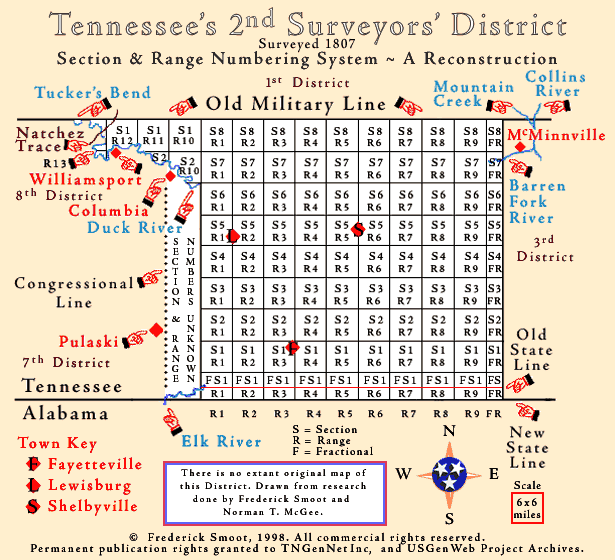Introduction
There is no extant original 2nd District map, therefore the
placement of the townships is based on the entry of over 2,000 early
original 2nd District survey descriptions into a database and then
sorting them by Range and Section numbers and then matching those
numbers to the common physical landmarks in the various
townships.
Additionally, certain “proof” is offered by some Survey Notes,
1807, (TSLA Microfilm roll AC-1511). This microfilm shows some
original, single, range and section line surveys done in 1807 when the
2nd District was first surveyed.
In 1805 and early 1806, two treaty cessions, one by the Chickasaw and the other by the Cherokee, opened for white settlement, much of southern Middle Tennessee. Soon after, the United States Congress passed legislation allowing
Tennessee control over lands within its bounds. “... the United
States, in Congress assembled, on the eighteenth day of April, in the year of our Lord one thousand eight hundred and six, passed an act entitled ‘An act to authorize the State of Tennessee to issue grants and perfect titles to certain lands therein described, and to settle claims to the vacant and unappropriated lands within the same ...' ”
Then that very year, the Tennessee State Assembly established the
first seven of her Surveyor's Districts. A Register's Office was
established in Nashville. The office had jurisdiction over three West
(now called Middle) Tennessee Surveyors' Districts, the 1st, 2nd,
and 3rd. The surveyors' office for the second District was
established in Jefferson, in Rutherford County. Jefferson was located in
the 1st District, and was presumably chosen because there was no
practical inhabited place within the bounds of the then new 2nd District
to locate the office. William P. Anderson was appointed Surveyor General
for the 2nd District.
The bounds of the 2nd District were established as “...to
begin eighteen miles west of the south-east corner of the last mentioned
district [1st] to run south to the true meridian, to the southern
boundary of the State, for its eastern boundary, and to be bounded on
the west and south, by the Congressional Reservation, and on the north
and south, by the first district and the boundary of the State, and
shall be known and distinguished by the name of the Second
District.”
Perhaps this will be a clearer: the 2nd District was bounded to the east by the 3rd District, to the south by the southern Tennessee state line, to the west by the U. S. Congressional Reservation, and to the north by the 1st District.
Examination of the earliest individual tract surveys and the few remaining range and section line surveys prove the southern Tennessee state line and the Congressional line were in fact erroneously placed.
The Southern Tennessee State Line
and the
1806 U.S. Congressional Reservation Line
In 1806 the Congress of the United States passed the "Compact of 1806" which drew a line separating lower middle and all of western Tennessee from the rest of Tennessee, in order to reserve the vast area "lying west and south of the line" as "vacant and unappropriated" federal property "at the sole and entire disposition of the United States", and ceding all federal interest in Tennessee "lands lying east and north of the line".
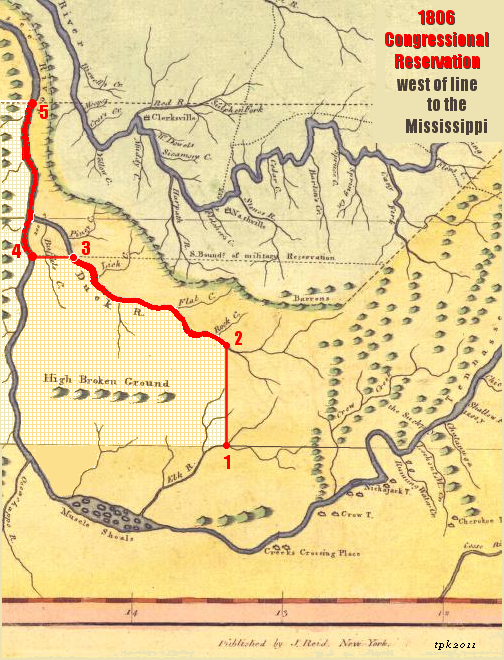
“beginning at the place where the eastern or main branch of Elk river shall intersect the southern boundary line of the State of Tennessee; from thence running due north, until said line shall intersect the northern or main branch of Duck river; thence down the waters of Duck river, to the military boundary line, as established by the seventh section of an act of the State of North Carolina [1783] ... thence with the military boundary line, west to the place where it intersects the Tennessee river; thence down the waters of the river Tennessee, to the place where the same intersects the northern boundary line of the state of Tennessee.”
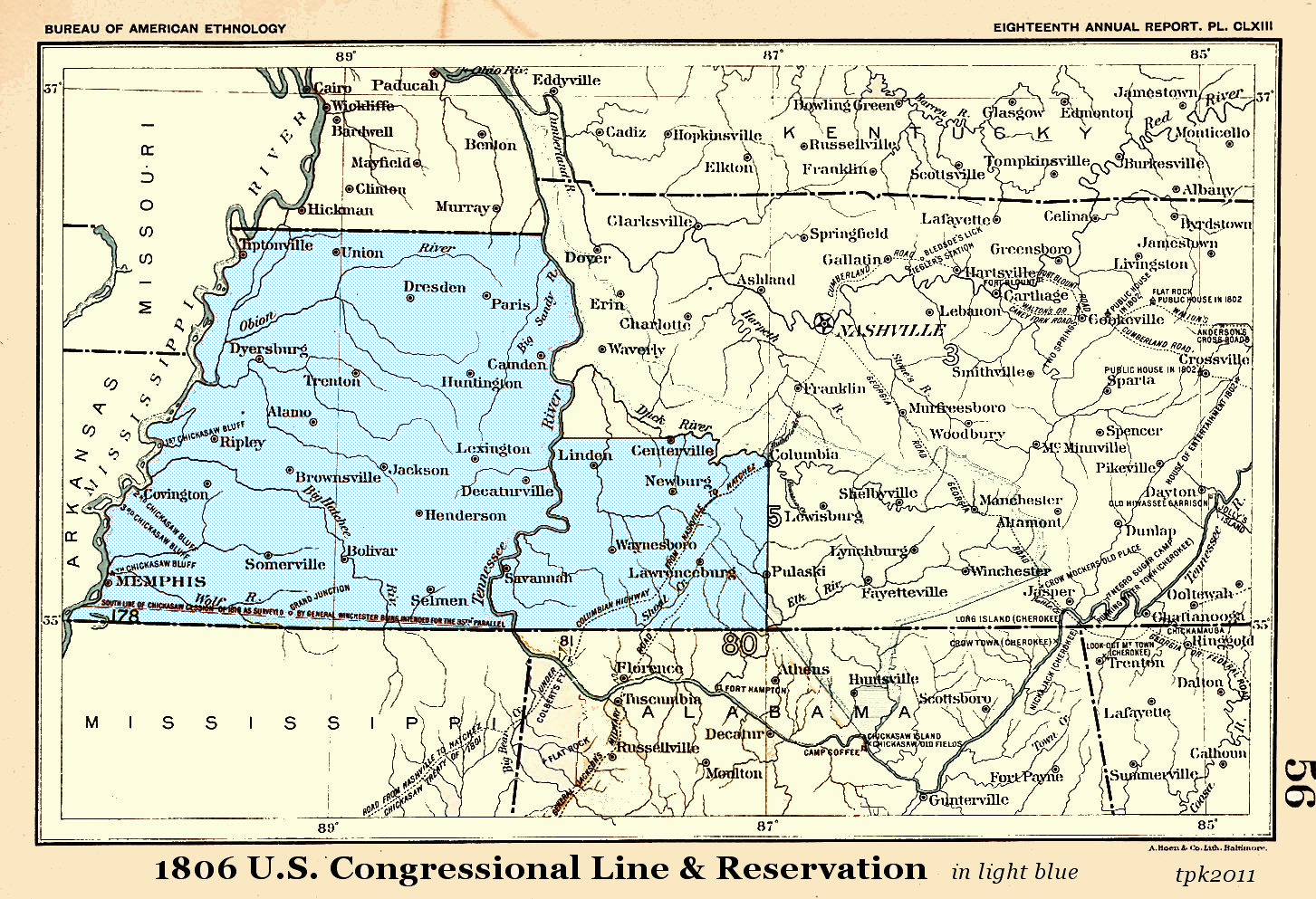
We find references to surveying of the Congressional line in old
individual tract surveys. The surveying of this line is attributed to
James Bright, a Deputy Surveyor in the 2nd District. (Survey #158, “
... the forty mile measure on Congressional line run by Bright from the State line. ” 10 September 1807; Survey #499, “... on Congressional Line run by Bright.” 9 June 1808.)
Because the state line was located too far north, it intersected with the Elk River too far east. Therefore, the Congressional line was placed too far east. The improper surveying of the state line is also attributed to James Bright. (Survey #503, “... on the State line run by James Bright.” 10 May 1808; Survey #1141, “... on State line run by James Bright.” 12 August 1808)
Soon after the establishment of the state line and the Congressional
line, the error was discovered (see dates above). According to noted Tennessee
historian, Timothy R. Marsh, the Tennessee Assembly rejected Bright's surveys. We find the lines were re-surveyed and corrected by Thomas Freeman and others. The state line was moved to the south, the Congressional line was moved to the west. We see references to two state lines. (Survey #1383, “... on the true State line.” 30 February 1809; Survey #1389. This tract is south side “of State the line run by James Bright.” 22 January 1809).
Mr. Marsh stated that from his research, he found that James Bright claimed that he had been influenced (perhaps intimidated?) by an earlier survey that had established the state line too far to the north. In defense of James Bright, we need to point out that it is the custom of surveyors to start from predetermined and accepted surveys. James Bright was a well respected surveyor in the 2nd District.
“Survey Notes, 1807”
Tennessee State Library & Archives Microfilm Roll AC-1511
In the spring of 1807, soon after the original state line and the
Congressional line surveys were completed, a team of surveyors were sent
out to survey the internal Range and Section lines in the 2nd District.
As is the custom of surveyors, they created “field notes” as
they went about their business, and later plats of their surveys were
created from those notes.
Some of those notes and plats survived and are in the hands of TSLA.
They are scant indeed, not complete, do not cover that part of the 2nd
District that is north of the Duck River and west of the Congressional
Line, yet they show us what that early surveyors did as they worked
their way through that new country.
Sometime past, a TSLA Archivist connected the tattered remnants
into usable pieces. In 1996, Dr Wayne Moore caused the microfilm to be produced
from the various survey plats. The graphic representations presented
here were made using the microfilm as the basis.
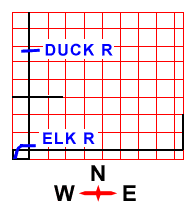
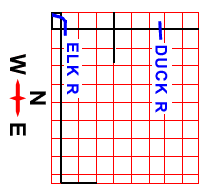
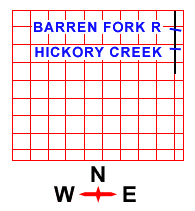
Notes
We find that our research is proven by the map work done by Timothy
R. Marsh. You will find a nice little
map showing township lines for Bedford County in his Land Deed
Genealogy of Bedford County Tennessee and another map of a slightly
lager area in his Land Deed Genealogy of Lincoln County
Tennessee. I
used Mr. Marsh's maps for my placement of Fayetteville and
Shelbyville on the map at the top of this page.
The original survey books have many errors and anomalies.
The improper recording (missing lines, etc.) contributed to
uncertainties. Perhaps in the
future, we will find more information and we will need to refine the
map.
The six mile square townships were called “sections” in
many early surveys.
Please consider that most of the area covered by this map was
Cherokee country
until January 1806. The towns came later.
All remaining Surveyors' District records may be found on microfilm.
See Tennessee State Library and Archives, Record Group 50.
Modern Counties in the Old 2nd District
(With Links to their Homepages)
Bedford
Cannon (southern part)
Coffee
Franklin
Giles (eastern part)
Grundy (small western part)
Lincoln
Marion (small western part)
Marshall
Maury (small eastern part)
Moore
Rutherford (southern part)
Warren (southwestern part)
Williamson (small southeastern part)
